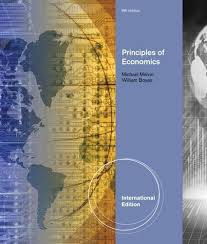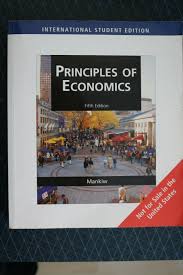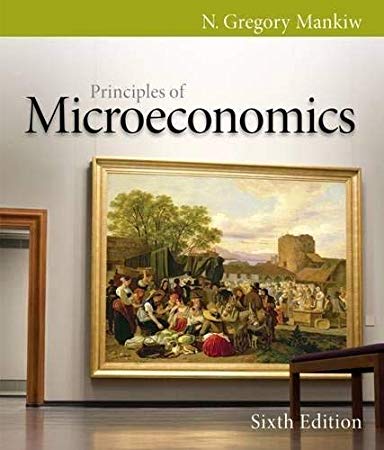Principles of Economics 6th Edition By N. Gregory Mankiw – Test Bank
Chapter 5 Elasticity and Its Application
Multiple Choice
1.In general, elasticity is a measure of
|
a. |
the extent to which advances in technology are adopted by producers. |
|
b. |
the extent to which a market is competitive. |
|
c. |
how firms’ profits respond to changes in market prices. |
|
d. |
how much buyers and sellers respond to changes in market conditions. |
ANS: D PTS: 1 DIF: 1 REF: 5-0
NAT: Analytic LOC: Elasticity TOP: Elasticity MSC: Definitional
2.Elasticity is
|
a. |
a measure of how much buyers and sellers respond to changes in market conditions. |
|
b. |
the study of how the allocation of resources affects economic well-being. |
|
c. |
the maximum amount that a buyer will pay for a good. |
|
d. |
the value of everything a seller must give up to produce a good. |
ANS: A PTS: 1 DIF: 1 REF: 5-0
NAT: Analytic LOC: Elasticity TOP: Elasticity MSC: Definitional
3.When studying how some event or policy affects a market, elasticity provides information on the
|
a. |
equity effects on the market by identifying the winners and losers. |
|
b. |
magnitude of the effect on the market. |
|
c. |
speed of adjustment of the market in response to the event or policy. |
|
d. |
number of market participants who are directly affected by the event or policy. |
ANS: B PTS: 1 DIF: 2 REF: 5-0
NAT: Analytic LOC: Elasticity TOP: Elasticity MSC: Interpretive
4.When studying how some event or policy affects a market, elasticity provides information on the
|
a. |
government expenditures associated with the policy. |
|
b. |
costs and benefits of the effect. |
|
c. |
allocative efficiency of the effect. |
|
d. |
direction and magnitude of the effect. |
ANS: D PTS: 1 DIF: 2 REF: 5-0
NAT: Analytic LOC: Elasticity TOP: Elasticity MSC: Interpretive
5.How does the concept of elasticity allow us to improve upon our understanding of supply and demand?
|
a. |
Elasticity allows us to analyze supply and demand with greater precision than would be the case in the absence of the elasticity concept. |
|
b. |
Elasticity provides us with a better rationale for statements such as “an increase in x will lead to a decrease in y” than we would have in the absence of the elasticity concept. |
|
c. |
Without elasticity, we would not be able to address the direction in which price is likely to move in response to a surplus or a shortage. |
|
d. |
Without elasticity, it is very difficult to assess the degree of competition within a market. |
ANS: A PTS: 1 DIF: 2 REF: 5-0
NAT: Analytic LOC: Elasticity TOP: Elasticity MSC: Interpretive
6.When consumers face rising gasoline prices, they typically
|
a. |
reduce their quantity demanded more in the long run than in the short run. |
|
b. |
reduce their quantity demanded more in the short run than in the long run. |
|
c. |
do not reduce their quantity demanded in the short run or the long run. |
|
d. |
increase their quantity demanded in the short run but reduce their quantity demanded in the long run. |
ANS: A PTS: 1 DIF: 2 REF: 5-0
NAT: Analytic LOC: Elasticity TOP: Elasticity MSC: Applicative
7.A 10 percent increase in gasoline prices reduces gasoline consumption by about
|
a. |
6 percent after one year and 2.5 percent after five years. |
|
b. |
2.5 percent after one year and 6 percent after five years. |
|
c. |
10 percent after one year and 20 percent after five years. |
|
d. |
0 percent after one year and 1 percent after five years. |
ANS: B PTS: 1 DIF: 2 REF: 5-0
NAT: Analytic LOC: Elasticity TOP: Elasticity MSC: Applicative
8.Which of the following statements about the consumers’ responses to rising gasoline prices is correct?
|
a. |
About 10 percent of the long-run reduction in quantity demanded arises because people drive less and about 90 percent arises because they switch to more fuel-efficient cars. |
|
b. |
About 90 percent of the long-run reduction in quantity demanded arises because people drive less and about 10 percent arises because they switch to more fuel-efficient cars. |
|
c. |
About half of the long-run reduction in quantity demanded arises because people drive less and about half arises because they switch to more fuel-efficient cars. |
|
d. |
Because gasoline is a necessity, consumers do not decrease their quantity demanded in either the short run or the long run. |
ANS: C PTS: 1 DIF: 2 REF: 5-0
NAT: Analytic LOC: Elasticity TOP: Elasticity MSC: Applicative
The Elasticity of Demand
1.The price elasticity of demand measures how much
|
a. |
quantity demanded responds to a change in price. |
|
b. |
quantity demanded responds to a change in income. |
|
c. |
price responds to a change in demand. |
|
d. |
demand responds to a change in supply. |
ANS: A PTS: 1 DIF: 1 REF: 5-1
NAT: Analytic LOC: Elasticity TOP: Price elasticity of demand
MSC: Definitional
2.The price elasticity of demand measures
|
a. |
buyers’ responsiveness to a change in the price of a good. |
|
b. |
the extent to which demand increases as additional buyers enter the market. |
|
c. |
how much more of a good consumers will demand when incomes rise. |
|
d. |
the movement along a supply curve when there is a change in demand. |
ANS: A PTS: 1 DIF: 1 REF: 5-1
NAT: Analytic LOC: Elasticity TOP: Price elasticity of demand
MSC: Definitional













Reviews
There are no reviews yet.